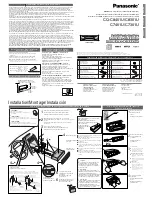
Function-Decoders MX681, MX685, MX686, MX687, MX688 Page 7
CV
Denomination
Range
Default Description
#19
Consist address
0 - 127
0
A common consist address for 2 or more engines can
be entered in this CV to each loco of the same consist.
If CV #19 > 0: Speed and direction is governed by this
consist address (not the individual address in CV #1 or
#17+18); functions are controlled by either the consist or
individual address, see CV’s #21 + 22.
#21
Consist addr active for
F1 - F8
0 - 255
0
Functions defined here will be controlled by the consist
address.
Bit 0 = 0: F1 controlled by individual address
= 1:
…. by consist address
Bit 1 = 0: F2 controlled by individual address
= 1:
…. by consist address
………. F3, F4, F5, F6, F7
Bit 7 = 0: F8 controlled by individual address
= 1:
…. by consist address
,
#22
Consist addr active for
FL-F9-F27
0 - 63
0
Select whether headlights and/or functions F9
– F12 are
controlled via consist address or individual address.
Bit 0 = 0: F0 (forw.) controlled by individual address
= 1: …. by consist address
Bit 1 = 0: F0 (rev.) controlled by individual address
= 1: …. by consist address
Bit 2 = 0: F9 controlled by individual address
= 1:
…. by consist address
Bit 3 = 0: F10 controlled by individual address
= 1:
…. by consist address
Bit 4 = 0: F11 controlled by individual address
= 1:
…. by consist address
Bit 5 = 0: F12 controlled by individual address
=
…. by consist address
3.5 The second address in a function decoder
The second address in
CV #64 (short) or CV #67+68 (long)
is used as an alternative address for cars or coaches equipped with a function decoder. The second
address is usually the decoder address of a locomotive. If all coaches of a train are equipped with
function decoders using the loco address as the second address, the lights of all coaches can for ex-
ample be turned ON/OFF with a single loco function key.
S
ee chapter “Function mapping”.
The “virtual motor control” follows the commands of the second address, if one is defined (value > 0).
CV
Denomination
Range
Default Description
#64
Short
SECOND ADDRESS
1 - 127
0
The “short” (1-byte) second address;
it is active when CV #112, Bit 5 = 0.
#67
#68
Long
SECOND ADDRESS
128 -
10239
0
The “long” second address;
it is active when CV #112, Bit 5 = 1.
Note: In contrast to the “first long address”, the cab can-
not calculate the proper CV values automatically.
As a work around, program the desired second address
temporarily as the first address. Then read out CV’s
#17/18 and enter these values in CV’s #67/68. Program
the first address back to the original address, if used.*
#112
Special ZIMO
configuration bits
0, 8, 32,
40
2
Bit 1 = 0: Normal
“service mode” acknowledgement.
= 1:
Special “high frequency” acknowledgement;
because LED
s typically don’t draw enough
current for “service mode” acknowledgement.
Bit 5 = 0:
Select between “short” or
= 1:
“long” second address
*The calculation is explained on the last page of this instruction manual
3.6 Analog operation
All ZIMO decoders are capable of operating on conventional layouts operated with DC power packs, in-
cluding PWM throttles, in
analog DC
as well as in
analog AC
(Märklin including the high voltage pulse
for direction change).
To allow analog operation
CV #29, Bit 2 = 1
must be set.
CV
Denomination
Range
Default Description
#29
Configuration Data #1
0 - 63
14 =
0000 1
1
10
includes
Bit 2 = 1
(Analog
operation
enabled)
Bit 0 - Train direction:
0 = normal, 1 = reversed
Bit 1 - Number of speed steps:
0 = 14, 1 = 28
Bit 2
– Automatic switchover to analog:
0 = disabled 1 = enabled
Bit 3 -
RailCom (“bidirectional communication“)
0 = deactivated 1 = activated
Bit 4 - Individual speed table:
0 = off, CV #2, 5 and 6 are active.
1 = on, according to CV s #67
– 94
Bit 5 - Decoder address:
0 = primary address as per CV #1
1 = ext. address as per CV #17+18


































